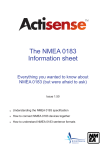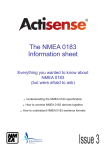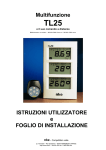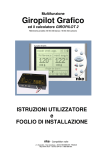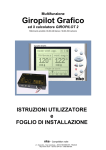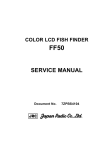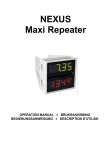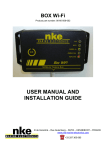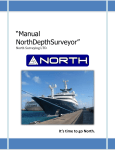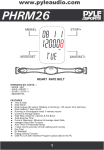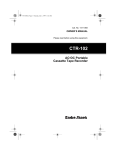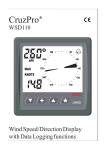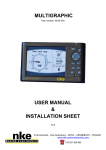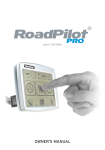Download Multifunction USER GUIDE INSTALLATION GUIDE
Transcript
Multifunction TL25 and its remote control Product reference : 90-60-244 white / 90-60-256 black USER GUIDE and INSTALLATION GUIDE REV : 1 nke – marine electronics Z.I. Kerandré – Rue Gutenberg – 56700 HENNEBONT- FRANCE http://www.nke.fr – After sale service n° 0 892 680 656. TABLE OF CONTENT 1 USING ................................................................................................................................... 3 1.1 PRESENTATION..................................................................................................................... 3 1.2 LIST OF CHANNELS CREATED ................................................................................................. 5 1.3 KEYPAD FUNCTIONS OF THE REMOTE CONTROL ....................................................................... 6 1.4 CHANNEL SELECTION ............................................................................................................ 6 1.5 W HAT IS A SUB-CHANNEL ...................................................................................................... 7 1.6 ALARMES SETTING ................................................................................................................ 8 1.7 FILTERING OF THE CHANNELS............................................................................................... 10 1.8 LIGHTING SETTING .............................................................................................................. 11 1.9 UNITS ................................................................................................................................. 12 1.10 ZERO SETTING OF THE DAILY LOG ...................................................................................... 13 1.11 CHOICE OF LANGUAGES ................................................................................................... 14 1.12 USE OF THE CHRONOMETER ............................................................................................. 15 1.13 NMEA LINK .................................................................................................................... 16 1.14 TECHNICAL SPECIFICATIONS ............................................................................................. 18 1.15 VERSION AND ADDRESS NUMBER OF THE DISPLAY .............................................................. 18 1.16 DIAGNOSTIC FOR 1ST LEVEL TROUBLESHOOTING. ................................................................ 18 1.17 TL25 INITIALISATION : SEE CHAPTER 4.8............................................................................ 18 2 SENSOR CALIBRATION .................................................................................................... 19 2.1 SETTING PROCEDURE OF THE CALIBRATION COEFFICIENT: ...................................................... 19 2.2 OFFSET SETTING PROCEDURE ............................................................................................. 19 2.3 AUTOCOMPENSATION OF THE FLUXGATE COMPASS ................................................................ 20 3 INSTALLATION .................................................................................................................. 21 3.1 3.2 3.3 3.4 3.5 3.6 3.7 3.8 PACKING LIST : ................................................................................................................... 21 LIST OF ACCESSORIES ......................................................................................................... 21 INSTALLATION PRECAUTIONS................................................................................................ 21 MOUNTING ON MAST FOOT SUPPORT .................................................................................... 22 W ALL MOUNTING ................................................................................................................ 23 CONNECTION TO THE TOPLINE BUS AND TO THE NMEA BUS OF THE INSTALLATION ................... 24 IDENTIFICATION OF THE CABLE WIRES ................................................................................... 24 TL25 AND REMOTE CONTROL INITIALIZATION ......................................................................... 25 -2– TL25 User guide–- 33-60-021-000 1 USING 1.1 Presentation The Multifunction TL25 is a display from the TOPLINE range. Its three screens, with high definition LCD technology, offer excellent readability and a wide angle of view of the data displayed, whether by daylight or at night. It is connected to the TOPLINE bus of your Chanel name Data value Alarm signal Unit installation and displays all the channels available on the bus. The TL25 is controlled using either a cable remote control or a radio remote control (not included with the product). -3– TL25 User guide–- 33-60-021-000 Architecture of the installation The presence of the equipment in the following diagram is for information only, and does not represent the equipment of your installation. TL 25 BOAT SPEED 16.85 KNOTS APP WIND A 105DEGRES DEPTH 10.50 METERS nke input NMEA NMEA + NMEA - log depth interface 90-60-450 Cable TOPLINE 20-61-001 GND DATA black 12VDC white connecting box 90-60-417 Figure 1 -4– depth log speedomètre TL25 User guide–- 33-60-021-000 1.2 List of channels created The master display, whether it is the TL25 or any other TOPLINE display, and each TOPLINE sensor, automatically create their respective channels when they are connected to the TOPLINE bus. Channel designation Magnetic heading Apparent wind angle Apparent wind speed Depth Boat speed Channels created Maximum and average speed by the Distance and bearing to man over board TL25 Configuration when set as Bus voltage master display VMG CMG True wind speed True wind angle True wind direction Corrected heading Estimated distance Estimated angle Total log Tip log Target speed NMEA Performance channels displayed Heading on other side Optimum wind angle Optimum VMG angle Optimum CMG angle Efficiency at close-haul NMEA channels displayed Polar efficiency Speed over Ground and Course over ground Cross-track error Please note that the channels MAX SPD and AVERAGE SPD can be accessed when the TL25 is master. In this case, these channels are displayed alternatively on one single screen. By default, this channel is calculated using the surface speed, and in the absence of the latter it will be calculated using the bottom speed. These average and maximum values are calculated from the last power-up of your installation. You can reset these channels to zero, without switching off the bus : select the channel key for 2 seconds. MAX SPD and AVERAGE SPD then press the -5– TL25 User guide–- 33-60-021-000 1.3 Keypad functions of the remote control key Press this key to select one of the three display screens of the TL25. The selected screen flickers. Low key and High key These keys allow to select a different channel to the one already displayed. They also allow to increment or decrement a data which is in the process of being modified. key The remote control also enables you to control the other displays of your TOPLINE installation, the address of which is lower than the address of the remote control. Press this key to select the TOPLINE display, which you wish to operate. Ent key This key allows to access the sub-channels and to validate the settings you implement. Brief pressure on this key also allows to set the level of lighting. Mob Man Over Board key Press this key for 5 seconds, and the function «Man Over Board» is activated. When a speedometer and a compass are connected to the TOPLINE bus, the displays then automatically indicate the estimated heading and distance to reach the man over board. If your installation only comprises a speedometer, then only the estimated distance will be displayed. To disable the «Man Over Board» alarm, you must cut off the power supply of your TOPLINE installation. CAUTION : the calculation of the estimate, for the Man Over Board function, does not take into account the drift of the boat caused by the current and the wind. For more detailed information, please refer to the remote control user guide. 1.4 Channel selection The three screens of the TL25 are independent. Using the remote control, configure the display according to your requirements. Examples of configuration: TL 25 TL 25 BOAT SPEED BOAT SPEED 16.85 16.85 KNOTS NOEUDS APP WIND A APP WIND A 105DEGREES 105 DEGREES COMPAS HEAD DEPTH 10.50 METRES 274° DEGREES nke nke -6– TL25 User guide–- 33-60-021-000 1.4.1 Procedure TL 25 BOAT SPEED 16.85 NOEUDS APP WIND A 1 105 DEGREES COMPAS HEAD 274° Using the key , select the row from wich you wish to change the channel. The selected row flikers. DEGREES nke 2 TL 25 DEPTH 50.20 METRES Using the key select in the list, the channel you wish to display. The new display is save in memory Figure 2 CAUTION : if your installation is equipped with several TOPLINE displays, make sure that the remote control controls the display which you wish to operate. Press the key repeatedly, until the intended display blinks. 1.4.2 List of channels displayed The master display, whether it is the TL25 or any other TOPLINE display, and each TOPLINE sensor, automatically create their respective channels when they are connected to the TOPLINE bus. You will find the list of created channels in annex 1. 1.5 What is a sub-channel The sub-channels are made to modify setting and display parameters of the channels. For example, the sub-channels of the surface speed channel are: - offset and calibration coefficient : setting parameters of the log-speedometer sensor, - the measurement unit : in knots or in km/hr, - filter setting, - high alarm and low alarm setting. The same applies to all channels present on the TOPLINE bus. The following chapters provide detailed explanations on how to access the sub-channels and implement the settings. -7– TL25 User guide–- 33-60-021-000 1.6 Alarms setting The setting of an alarm enables you to monitor the value of a channel. When the preset threshold is exceeded, a warning message is displayed and an audible alarm is activated. For example, you can set an upper threshold and a lower threshold on the surface speed channel. High alarm is activated when the display is higher than the programmed threshold. Low alarm is activated when the display is lower than the programmed threshold. To cancel the alarm of a channel, enter the value 0 in the upper alarm and the lower alarm. Thus, the setting of the alarms will allow you to supervise your TOPLINE installation effectively as well as the good operation of your boat. Note that for angular channels such as magnetic heading or wind angle, the sub-channels of alarms are the alarm base and the alarm range. 1.6.1 Setting procedure TL 25 BOAT SPEED 16.85 KNOTS Using the key , select the channel APP WIND A 1 105DEGRES from wich you wish to set an alarm. DEPTH 10.50 METRES The selected row flikers. nke 2 TL 25 HIGH ALARM 0.25 3 HIGH ALARM 0 4 TL 25 5 TL 25 LOW ALARME 20 BOAT SPEED 16.85 KNOTS Press and hold the key Ent until the sub-channel ALARM appears. Release the key. Then successively press the key Ent to select the sub-channel LOW ALARM ou HIGH ALARM set the new alarm value "20" Using the keys Validate and exite the alarm menu by maintaining pressure on Ent The new value is saved in memory Figure 3 CAUTION : if your installation is equipped with several TOPLINE displays, make sure that the remote control controls the display which you wish to operate. Press the key repeatedly, until the intended display flickers. -8– TL25 User guide–- 33-60-021-000 1.6.2 Alarms activation procedure After having set the alarms, you can activate or disable all the alarms. When alarms are activated, the alarm symbol below appears at the bottom left of the display : TL 25 BOAT SPEED 16.85 KNOTS Using the keys APP WIND A 1 105DEGREES select the channel CONFIG COMP HEAD 274° DEGREES nke 2 TL 25 CONFIG NO 3 VALID ALARME YES Press and hold the key Ent until the sub-channel valid alarme appears. Release. Using the keys select YES Validate by maintaining pressure on the key Ent After 5 s, the TL25 automatically exits the setting mode Figure 4 -9– TL25 User guide–- 33-60-021-000 1.7 Filtering of the channels The level of filtering of a channel determines the frequency of update of the data displayed. For example, in rough sea when the boat moves significantly, it is useful to increase the filtering of the speed channel to stabilise the value displayed. Conversely, in calm sea, low filtering will be preferable to obtain a fast response of the display. Filtering is adjustable between 1 and 32, and the default value is 8. The lower this value is, the higher the frequency of update is. Filter setting procedure TL 25 BOAT SPEED 16.85 KNOTS APP WIND A 1 105DEGREES COMP HEAD 274° DEGREES nke 2 TL 25 HIGH ALARM 0.25 3 TL 25 FILTERING 8 4 select the channel you need to change the filtering. The selected channel flickers Presse and hold the key Ent until high ALARM appears. Release. Then successively press the key Ent to select the sub-channel FILTERING TL 25 FILTERING 10 5 Using the key TL 25 BOAT SPEED 16.85 Using the key set the new filtering value 10 Validate and exits the menu by maintaining a pressure un key Ent The new filtering value is saved in memory Figure 5 - 10 – TL25 User guide–- 33-60-021-000 1.8 Lighting setting The TL25, as well as the other displays of the TOPLINE range, have five levels of backlighting : 0 = no lighting, 1 corresponds to the minimum level of lighting and 4 to the maximum level. You have the option to set the level of lighting, either on the TL25 only, or on every TOPLINE display of your installation : 1.8.1 TL25 setting procedure TL 25 BOAT SPEED 1 16.85 NOEUDS APP WIND A 105 Press the key Ent of the remote control DEGREES COMPAS HEAD 274° DEGREES nke TL 25 REGL NIVEAU 1 2 LIMI7RE Using the key set the lighting level from 0 to 4 VENT ANG/A 105 DEGRES CAP MAGN 274° After 5 second the TL25 exit automatically this menu. The lighting level is saved un memory DEGRES nke Figure 6 1.8.2 Setting procedure for every display of your installation Follow the above procedure, then press on the Ent - 11 – key to apply the setting to every display. TL25 User guide–- 33-60-021-000 1.9 Units You have the option to choose the display units of the channels: - in knots or in km/hr for the log/speedometer, - in knots or m/s for the anemometer, - in degree Fahrenheit or in degree Celsius for the temperature - in meters or in feet for the sounder Unit setting procedure TL 25 BOAT SPEED 16.85 NOEUDS APP WIND A 1 105 DEGREES Using the key select the channel for which you wish to change the unit COMPAS HEAD 274° DEGREES The selected channel flickers nke 2 TL 25 BOAT SPEED 16.85 KNOTS 3 Ent until the sub-channel UNIT appears. Release. TL 25 UNIT KM/H 4 Press and hold the key TL 25 BOAT SPEED 31.20 km/h select the UNIT Using the keys Validate and exit the setting by maintaining the pressure on Ent The new unit is saved to the memory. In approximataly 5 or 6 seconds, display will revert to value. Figure 7 - 12 – TL25 User guide–- 33-60-021-000 1.10 Zero setting of the daily log The channels daily log and total log are at your disposal on your display. You will use the daily log to count the number of nautical miles completed during a sailing leg. The value is kept in memory when the power supply of your installation is cut off. Resetting the daily log channel to zero will allow you to count the number of nautical miles of the following sailing leg. The total log indicates the number of nautical miles completed since the installation of your depth-finder log interface. Only a complete initialisation of your depth-finder log interface allows to reset the total log to zero. It is performed by initialising the surface speed channel. Zero setting procedure of the daily log TL 25 TRIP LOG 1805 MILES Using the key APP WIND A 1 105 DEGREES sélect the channel trip log COMPAS HEAD 274° DEGREES nke 2 TL 25 TRIP LOG 1805 Press the key MILES 3 and hold (approx 6 sec) to set " 0" TL 25 TRIP LOG 0MILES The trip log is set to " 0" Figure 9 - 13 – TL25 User guide–- 33-60-021-000 1.11 Choice of languages You can configure the TL25 in one of these six available languages : French, English, Italian, Spanish, German and Dutch. TL 25 BOAT SPEED 16.85 NOEUDS APP WIND A 1 105 DEGREES Using the keys COMPAS HEAD 274° DEGREES select the channel CONFIG nke 2 TL 25 CONFIG NO 3 LANGUAGE Press the key and hold Ent until the sub-channel valid alarm appears. Release.. Press once more the key Ent Using the keys select english (for example) FRENCH LANGUAGE ENGLISH to select Language Valid by maintaining pressure on the Key Ent After 5s, the TL25 automatically exits this menu Figure 10 - 14 – TL25 User guide–- 33-60-021-000 1.12 Use of the race timer The display includes a regatta race timer. Times by default are T1= 6min and T2 = 4min. 1.12.1 Starting the race timer TL 25 BOAT SPEED 16.85 NOEUDS APP WIND A 1 105 DEGREES COMPAS HEAD Using the keys 274° DEGREES select the channel racetimer nke 2 TL 25 RACETIMER 00.00 min / sec 3 Ent until the display 06:00 appears TL 25 RACETIMER 06.00 min / sec 4 Press the key and hold The racetimer is ready TL 25 RACETIMER GO Press the key Ent to start the racetimer MIN / SEC Figure 11 During countdown, the last 5 seconds are signalled by a BEEP, then the START signal is given by the alarm. Note that if you did not start the race timer exactly at the start signal, you can synchronise the countdown at T2 by pressing the Ent key. During the procedure, you can also return to the initialization value by pressing the Ent key for 2 seconds. The race timer displays T1 = 6.00 minutes for a new start. 1.12.2 Setting of T1 and T2 This setting can only be performed on the master display of your installation. − select the race timer channel, using the − press Ent and keys, until the message T1 setting appears, − change the value of T1 using the Ent and keys, then confirm with , and arrow keys, then confirm with the − the message T2 setting appears, − change the value of T2 using the Ent − after 5 seconds, the TL25 will automatically leave the setting mode. - 15 – TL25 User guide–- 33-60-021-000 key, 1.13 NMEA link The TL25 includes an NMEA input, allowing the connection of a GPS, a PC, meteorological sensors, etc. After performing the NMEA initialisation of the TL25, the NMEA channels corresponding to the frames transmitted by the instrument are available on the TOPLINE bus. You can then display data. Please note that if an instrument transmits an NMEA frame which is already created by an nke sensor, then this frame will not be taken into account. 1.13.1 Connection of the NMEA link The NMEA input of the TL25 only allows the connection of one instrument providing NMEA frames (see chapter 16). If you wish to connect a second instrument (for example a GPS and a PC), you must connect it either to the NMEA input of another display, or to a TOPLINE NMEA INPUT INTERFACE box (ref : 90-60-055). 1.13.2 NMEA initialisation procedure − Select the CONFIG channel on the upper display, − Press and hold the key until the message «INIT NMEA» appears. Release the key. The TL25 subsequently performs a sequence of NMEA data search for 20 seconds, then it creates the new channels corresponding to the NMEA frames transmitted by the instrument. The NMEA channels created are saved in the display memory and restored every time it is powered up. 1.13.3 Characteristics of NMEA data The NMEA frames identified by the TL25 are in conformity with the NMEA standard 0183 V2.30 (or lower version). The NMEA input is insulated by an optocoupler. The format of the frames is : 4,800 bauds / 8 bits with bit 7 at 0 / 1 start bit and 1 stop bit. Distances are truncated to the lower value. The other dimensions are rounded to the nearest unit (ex : degrees for angles). A frame can be partially empty between commas. The TL25 will take the missing data in another frame (ex : speedometer in VWH and compass in HDG). The depth in feet will be identified if it does not exist in meters for example. A channel can be included in several frames (ex : the compass is taken in HDG in priority, if not in HDM, if not in VHW). If the bottom heading or the WP heading do not exist in magnetic, the true heading is taken. Refreshing of the display of the NMEA channels is performed each time a new valid NMEA frame is received. If the NMEA link is lost (example : loss of satellites on the GPS) the last received data will remain on the display for 64 seconds. After that, the TL25 will signal the breakdown. - 16 – TL25 User guide–- 33-60-021-000 1.13.4 Frames identified by the TL25 NMEA Description Frame TOPLINE channels created $xxGLL Latitude, longitude, time and quality index LAT_DEGMIN, LAT_MILMIN, LON_DEGMIN, LON_MILMIN. $xxGGA Latitude, longitude and time LAT_DEGMIN, LAT_MILMIN, LON_DEGMIN, LON_MILMIN. $xx-ZDA Date and time ANNMOIS, HEUJOUR, MINSEC. $xxRMC Latitude, longitude, date, time, SOG, COG and magnetic variation : in minimum data ; ANNMOIS, HEUJOUR, MINSEC. $xxVTG COG, SOG CAP_FOND, V_FOND. $xxXTE Cross-track error ECART_ROUTE, B_PILOT, C_WP_OD. $xxAPB Automatic pilot in A format ECART_ROUTE, B_PILOT, C_WP_OD. $--RMB XTE, latitude, longitude and distance and heading to destination (DTW and BTW) in minimum data. A_WP, D_WP $xxBWC Bearing and Distance to Waypoint A_WP, D_WP $xxXDR Measurement transmitter : stays tension or TEN_ETAIS. temperature $xxHDG Magnetic heading, deviation and variation COMPAS, R_COMPAS. $xxVHW Surface speed, magnetic and true heading COMPAS, R_COMPAS, SPEEDO $xxHDM Magnetic heading, deviation and variation COMPAS, R_COMPAS. $xxVLW Surface distance LOCHJ, LOCHT. $xxDBT Depth beneath transducer PROF $xxDPT Depth beneath transducer and offset PROF $xxMTW Water temperature TEMP_EAU. $xxMWV Wind speed and wind angle ANG_VENT_APP, R_ ANG_VENT_APP, ANEMO. $xxVWR Apparent wind speed and wind angle ANG_VENT_APP, R_ ANG_VENT_APP, ANEMO. $xxMMB Atmospheric pressure BARO_2. $xxMTA Air temperature TEMP_AIR $PNKEP,01 Target speed VIT_CIBLE. $PNKEP,02 Heading at next board CAP_AUTRE_BORD. $PNKEP,03 Optimum upwind angle ANGLE_OPT_VENT, REND_PRES, REND_POLAIRE. $PNKEP,04 Angles to optimise the CMG and VMG and gain ANGLE_OPT_CMG, ANGLE_OPT_VMG, GAIN_ROUTE_CMG, GAIN_ROUTE_VMG. $PNKEP,05 Current direction and speed DIREC_COURANT, VITES_COURANT. - 17 – TL25 User guide–- 33-60-021-000 1.14 Technical specifications - Power supply : 10 to 16VDC Consumption : 20mA without lighting and 70mA with lighting. Tightness : IP67 Weight : 1.3kg including cable Dimensions : height = 260mm ; width = 156mm ; thickness = 45mm Operating temperature : -10°C to +50°C Storage temperature : -20°C to +60°C Horizontal viewing angle : superior to 120° Vertical viewing angle : superior to 90° Height of the characters displayed : 25 mm for the channel, and 10 mm for the identifier and the unit. 1.15 Version and address number of the display You can check the software version of the display and its address in the list. In order to do that, select the CONFIGURATION channel, then press the Ent key for 5 seconds. The date, time and version of the TL25 software are then momentarily displayed on the screen. 1.16 Diagnostic for 1st level troubleshooting. Before contacting technical support, please check the troubleshooting table below. Problem Possible causes and solutions The Topline installation does not detect the TL25 The bus cable is not or is badly connected to the terminal box : check the plugging and the connection inside the terminal box. Check the state of the cables : they must not show any sign of wear or cut. The remote control does not control the TL25 The address of the remote control is lower than that of the TL25 : reinitialise the remote control, see chapter 17. The TL25 is set at the address « 0 » : perform its initialization, see chapter 17. The TL25 displays the message « data wire error » Check that the black data wire is connected at the right location in the terminal box : see chapter 17 The TL25 displays the message « collision error » It is possible that there are two master displays (at address 1) on your installation : check the addresses, if it is the case, reinitialize one of the displays. The TL25 does not display the NMEA data : that from the GPS for example. Has the NMEA link been initialized ? see chapter 16 Your display indicates battery fault. Check the voltage of your battery with a voltmeter : the operating voltage must be higher than 10VDC. Check the charge behaviour of your battery. The NMEA link is not or is badly connected to the terminal box : check the connection of the TL25 and that of the NMEA transmitter (GPS). If you do not manage to solve the problem, please contact your distributor. 1.17 TL25 initialization : see chapter 4.8 - 18 – TL25 User guide–- 33-60-021-000 2 SENSOR CALIBRATION Every nke sensor is adjusted at the factory. However, a calibration is required to adapt the sensor to the specificities of your boat and to obtain an optimum measurement accuracy. Follow the calibration procedure below, by visualising the settings on a display. Please refer to the installation notice of the TOPLINE sensor that you wish to calibrate 2.1 Setting procedure of the calibration coefficient: TL 25 BOAT SPEED 16.85 Using the key , select the channel, NOEUDS APP WIND A 1 105 DEGREES COMPAS HEAD 274° you wish to set the coefficient of calibration. The selected channel flickers. DEGREES nke 2 TL 25 In order to access to the list of sub-channel UNIT, CALIB COEF & OFFSET,. UNIT KNOTS press and hold downthe key Ent , until the sub-channel UNIT appears then release. 3 TL 25 4 TL 25 5 TL 25 CALIB COEF Press successively the key Ent to select CALIB COEF. CALIB COEF 1.20 BOAT SPEED 16.85 KNOTS Using , set the new coefficient 1.20 Validate and exit by maintinning Ent The coefficient is saved in memory Figure 12 CAUTION : - The calib coef parameter is a multiplier coefficient. This value must never be equal to zero. By default this coefficient is set to 1.00. If it is not the case, before starting a calibration enter the value 1.00. 2.2 Offset setting procedure Follow the above procedure and select the OFFSET sub-channel. Note that the offset default value is 0. - 19 – TL25 User guide–- 33-60-021-000 2.3 Autocompensation of the fluxgate compass It is possible that on some boats, the Fluxgate Compass may be strongly disrupted by its environment. Despite a careful installation and an offset properly adjusted, an important difference remains between the magnetic heading displayed and the true magnetic heading, throughout the measurement range between 0 and 359°. In this case, you must perform an autocompensation of the Fluxgate Compass to achieve an acceptable level of accuracy. Please refer to the installation guide of the Fluxgate Compass sensor. 2.3.1 Principle of autocompensation The operation consists in executing, at a rigorously rotation constant speed, a perfect circle with your boat, clockwise. While the boat describes this circle, the sensor will record the measurement points of a deviation curve, every 10° with an accuracy of 0.25°. Thus, your Fluxgate Compass will be accurately corrected between 0 and 359°. CAUTION : the autocompensation operation of the Fluxgate Compass requires precision in the execution of the circle : constant speed of 2 to 3 knots and constant diameter of the circle. If you cannot maintain these two criteria, the autocompensation will not be successful. 2.3.2 Autocompensation procedure In order to achieve a successful autocompensation, you must navigate : - On smooth sea, with no current and no wind. Away from large magnetic masses such as cargo boats. In an open area allowing the execution of a circle with a diameter approximately 5 times the length of the boat. At a constant speed of about 2 or 3 knots. 1. Select, on the upper display, the magn head channel, 2. Select the middle display with the key 3. Start to describe the circle, then press the 8 seconds on the key ▼, to trigger the autocompensation procedure. 4. One single circle* is sufficient to perform the autocompensation correctly, when its a success, the message 3000 is indicated. * For the previous generation of compass, referenced as 90-60-005, at least three circles must be executed. In case of problem during autocompensation, the TL25 displays the PAN message , plus one code : - Code 1 : cancellation at user request. - Code 2 : detection of a gyration in the opposite direction. Start again clockwise. - Code 3 : excessive variation between 2 heading measurements. Reduce the speed of your boat to 2 or 3 knots. - Code 4 : angle correction higher than 20°. Start t he autocompensation procedure over. In case of autocompensation error, the measurements are not saved to the memory and the sensor resumes its normal operating mode. - 20 – TL25 User guide–- 33-60-021-000 3 INSTALLATION This chapter describes the installation and the initialization of the TL25. IMPORTANT - Read this user guide entirely before starting the installation. Any electrical connection of the TL25 on the TOPLINE bus must be carried out with the terminal box 90-60-417 (equipped with a connection terminal for the NMEA input). Only use TOPLINE bus cable of the type 20-61-001. Any intervention on the TOPLINE bus must be carried out with the installation power switched off. 3.1 Packing list : - one Multifunction TL25 equipped with six meters of cable, including the TOPLINE bus and one NMEA input, - one user guide, - one protective cover - four M4 fixing screws 3.2 List of accessories Standard terminal box TOPLINE bus : 90-60-121 Terminal box TOPLINE bus with NMEA input : 90-60-417 Bracket for 1 TL25 : 31-33-003 in aluminium, 31-33-015 in glass fibre painted white, 31-3313 in varnished carbon fibre - Bracket for 2 TL25, in glass fibre : 31-33-016 - Cable remote control : 90-60-245 - Wireless remote control : 90-60-258 Protective cover : 31-33-002 white and 31-33-004 black - 3.3 Installation precautions The location of the TL25 must be : − so that the helmsman is able to easily read the data, − placed in a location away from potential shocks, − more than 40cm away from a magnetic compass, − more than 1 meter away from a VHF radio transmitter. The best readability of the TL25 is generally obtained by mounting it on a bracket. You can also wall mount it on any flat surface of the boat. Four M4x30mm fixing screws are provided with the TL25. The bracket is an accessory available at your distributor. - 21 – TL25 User guide–- 33-60-021-000 3.4 Mounting on bracket Make sure that the bracket you have chosen can be mounted your mast. Check that there is sufficient space behind the partition to make the cable run. If the cable runs inside the mast, make the cable pass through an opening equipped with a grommet. If the cable runs across the deck, make the cable pass through a tight stern tube gland. 3.4.1 Mounting procedure for the bracket - place the bracket on the mast foot, - using a pencil, locate the six fixing holes, then remove the bracket, - using a centre punch, mark the centre of each hole, - drill the holes with a diameter ∅ 5, - mount the bracket with the six fixing screws or six rivets (not included). 3.4.2 Mounting procedure of the TL 25 on the bracket - introduce the cable in the ∅18 drilled hole, - position the TL25 so that it faces the four ∅4 holes, - place the four screws (provided with the product) in the holes, from the back of the partition, - tighten the four fixing screws moderately. CAUTION : - When mounting the TL25, tighten the fixing screws moderately. Excessive tightening can cause the casing to break. - Do not use glue putty to mount the TL25. - 22 – TL25 User guide–- 33-60-021-000 3.5 Bulkhead mounting Make sure the location is clean, smooth and flat. Check that there is sufficient space behind the partition to make the cable run. Procedure - Perform the drillings of figure 13 on the partition, - Clean the mounting surface with alcohol, - Lay a very thin silicone sealing joint around the mounting perimeter, - introduce the cable in the ∅18 drilled hole, - position the TL25 so that it faces the four ∅5 holes, - place the four screws (provided with the product) in the holes, from the back of the partition, - tighten the four fixing screws moderately. Drill four holes Ø 5 mm at each angle Drill the side hole Ø 18 mm TL25 size : Figure 13 - 23 – TL25 User guide–- 33-60-021-000 3.6 Connecting the Topline bus and the NMEA connection 1. Make the bus cable run from the TL25 to the TOPLINE terminal box of your installation. 2. Connect the bus cable inside the terminal box. TL 25 BOAT SPEED 16.85 NOEUDS APP WIND A 105 DEGREES COMPAS HEAD 274° DEGREES nke ASupply 12Vdc Initialisation wire + input NMEA GND NMEA+ NMEA- init NMEA+ NMEA- NOIR GND BLANC GND NOIR GND BLANC 12VDC white 12V DATA black Connecting box 90-60-417 Figure 13 : connection of the TOPLINE bus If you reduce the length of the bus cable, strip and galvanise the wires before connecting them inside the terminal box. 3.7 Identification of the cable wires White cable 6 wires Wire identification +12V Topline Data GND White wire Black wire Braid Red wire Yellow wire Green wire TOPLINE Bus Initialisation wire (GND) NMEA + NMEA Input NMEA – - 24 – TL25 User guide–- 33-60-021-000 3.8 TL25 and remote control initialization At first power-up, you must initialize the TL25 so that an address is assigned to it. The display is delivered with the address set as 0. During the initialization, it will automatically insert itself in the list of instruments and displays of the TOPLINE bus of your installation : − either as master, at the address 1, if this address is available on the bus, − or as slave, if the address 1 is taken by a master, at an available address comprised between 2 and 20. Likewise, the remote controls must also be initialized. Please refer to the remote control user guide. 3.8.1 Initialization procedure: the TL25 is set at the address 0 your installation is powered off : disconnect the initialization red wire from the init terminal (GND), power up your installation : the TL25 then performs an auto-test, when the message «connect the red wire» appears, reconnect the red wire on init (GND) : the TL25 then takes an address available on the bus, the TL 25 is then initialized. - CAUTION : − the remote control(s) of your installation must be assigned to an address higher than that of the TL25. To achieve that, you must first initialize the TL25 then the remote control(s). − The initialization red wire must be connected to the init terminal in normal operation. 3.8.2 Reinitialization procedure : the TL25 already has an address between 1 and 20 You may need to reinitialize the TL25, for example to have another address assigned to it. - your installation is powered off : disconnect the initialization red wire from the init terminal (GND), - power up your installation : the TL25 performs an auto-test then takes the address 0, when the message «connect the red wire» appears, reconnect the red wire on init (GND) : the TL25 takes an address available on the bus, the TL 25 is then initialized. - - 25 – TL25 User guide–- 33-60-021-000 NOTES _____________________________________________________________________________________________________ _____________________________________________________________________________________________________ _____________________________________________________________________________________________________ _____________________________________________________________________________________________________ _____________________________________________________________________________________________________ _____________________________________________________________________________________________________ _____________________________________________________________________________________________________ _____________________________________________________________________________________________________ _____________________________________________________________________________________________________ _____________________________________________________________________________________________________ _____________________________________________________________________________________________________ - 26 – TL25 User guide–- 33-60-021-000 NOTES _____________________________________________________________________________________________________ _____________________________________________________________________________________________________ _____________________________________________________________________________________________________ _____________________________________________________________________________________________________ _____________________________________________________________________________________________________ _____________________________________________________________________________________________________ _____________________________________________________________________________________________________ _____________________________________________________________________________________________________ _____________________________________________________________________________________________________ _____________________________________________________________________________________________________ _____________________________________________________________________________________________________ - 27 – TL25 User guide–- 33-60-021-000 NOTES _____________________________________________________________________________________________________ _____________________________________________________________________________________________________ _____________________________________________________________________________________________________ _____________________________________________________________________________________________________ _____________________________________________________________________________________________________ _____________________________________________________________________________________________________ _____________________________________________________________________________________________________ _____________________________________________________________________________________________________ _____________________________________________________________________________________________________ _____________________________________________________________________________________________________ _____________________________________________________________________________________________________ - 28 – TL25 User guide–- 33-60-021-000




























